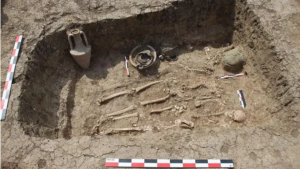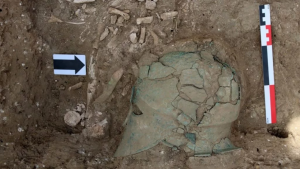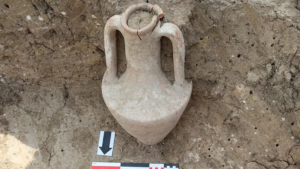Archaeologists of the Russian Academy of Sciences have discovered a Corinthian helmet in a grave from the 5th century BC; the first discovery of its kind north of the Black Sea.
The discovery took place in the Taman Peninsula, south-west of Russia, RIA Novosti of Archaeology News Network reports.
The helmet was found severely corroded and quite fragmented having been buried for approximately 2500 years as it is made of bronze.
Corinthian helmets appeared in Greece around the 6th century BC; an essential piece of military equipment for the foots soldiers of the fierce Greek phalanxes.
The goddess Athena, or Pericles, are also frequently depicted wearing them. What is special about this type of helmet is that it covers the entire head and neck areas, with slits for the eyes and mouth, and protruding cheek covers (paragnathides). A large curved projection protected the nape of the neck and the interior was padded with fabric or leather to protect the warrior’s skull. Often their crest was surmounted by a crest (lophos) with a horsehair plume.
According to Roman Mimohod, director of the expedition of the Institute of Archaeology of the Russian Academy of Sciences (IA RAS), “the helmet of the Taman peninsula belongs to the Corinthian Hermione-type and would date back to the first quarter of the fifth century BC.”
Several Greek colonies were indeed present in this region with a settlement extending from the end of the 7th century BC until the second quarter of the 4th century BC.
“These settlements were in very close contact with the Scythian inhabitants of the steppe,” another historian, Iraoslav Lebedynsky who specializes in ancient Eurasian cultures said.
Some cities founded by the Greeks in the region were Olbia, at the mouth of the Dnieper; Panticapaion, today’s Kerch, in the extreme west of the Crimea, and Chersonese (Sevastopol); on the Russian bank and Phanagoria (Taman) bearing the same name as the peninsula where Corinthian helmet was found.
Source: neoskosmos
Ask me anything
Explore related questions







